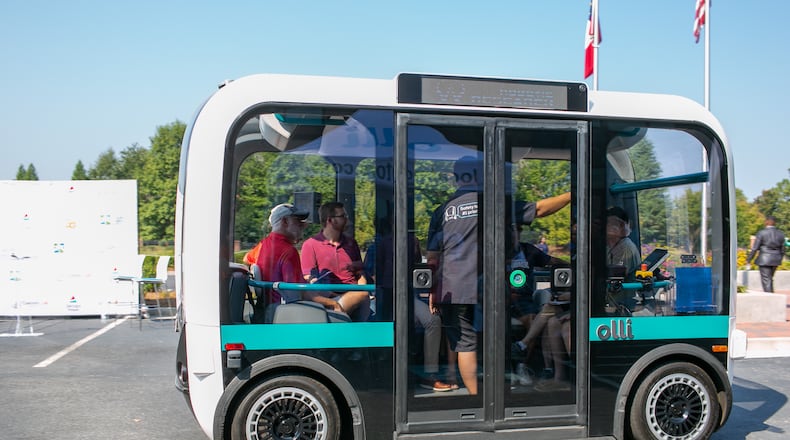The confluence of yet another feasibility study examining light rail on the Atlanta BetlLine, the Biden Administration’s intention to pass a major infrastructure bill, and the resurgence of Congressional earmarks has reinvigorated the debate over the future of mass transit in Atlanta.
For most of us who live in the city, the debate is not whether to invest in mass transportation — it’s how to do it. With the national political debate centering on infrastructure, it is clear that now is the time to push for an influx of much-needed federal transit dollars.
Unfortunately, the dollars are limited and appropriations will be divided between 50 states, hundreds upon hundreds of cities, and thousands of projects.
Credit: Courtesy photo
Credit: Courtesy photo
As such, it is incumbent upon our state and city leadership to both be responsible stewards of taxpayer money and opt for the transportation mechanism most likely to provide the desired benefits in the near- term. Notably, while the need for transportation hasn’t changed, the options for its provision have. The invention and subsequent rapid development of autonomous transit have brought about a more diverse set of transportation investment options for consideration. Autonomous, mass transit shuttles operating on geo-fenced closed loops are consistent, reliable, and, more importantly, cost-effective.
According to pre-pandemic MARTA estimates, light rail on the Beltline will cost upwards of $570 million and be complete sometime around 2045, assuming funding gaps are closed. Autonomous shuttles, on the other hand, can provide efficient, electric, and inexpensive mass transportation on the entire Beltline for a fraction of the cost.
Each electric autonomous shuttle costs approximately $500,000. To cover the whole Beltline with constantly circulating autonomous shuttles, you’d need nearly 200 shuttles (taking into account a third of the fleet would be charging at any one time). That would cost about $100 million, leaving more than $470 million left over. This surplus can be used for trail preparation and establishing a level and continually maintained vehicle track that would run parallel to the existing paved trail. That effort, while it will require financial investment, would be significantly less expensive than building out rail infrastructure, saving the taxpayer tens of millions of dollars.
In addition to being fiscally responsible, we should consider that the citizens of Atlanta have been patiently waiting for city leadership to provide transit on the Beltline for years. Transit was pitched as part of the original plan and city leaders have paid lip service to the idea for years. It is time to deliver. However, while rail has been the common refrain, technological advancements present us new, more readily available options that we did not previously have. In areas of the Beltline where foot and bike traffic is lower, autonomous shuttles can be operational in a matter of months. In more heavily trafficked areas, after a few months of path preparation, we could achieve our dream of Beltline transit. Cost-efficient, electric transportation available immediately — what’s not to like?
Finally, putting cost and time efficiency (both major federal priorities) aside, in a world where dollars are finite and transit projects are seemingly endless, we must tell a consistent story for why Beltline transit deserves federal funding. To do that, we should align our ask with the goals and aspirations of the administration — funding zero emission transit and boosting innovative industry.
By using autonomous vehicles to provide Beltline transit we will pitch a new story, one centered on innovation, green technology and forward-looking public policy, thereby aligning our goals with those of the Biden Administration and Democratic leadership in Washington and boosting our chances of federal support.
More than that, we would create an innovative transit corridor that would transform the public image not only of Atlanta and the Beltline but also of the region’s mass transit. An investment in autonomous shuttles will raise the local profile of our oft-beleaguered, unappreciated public transit agency. Innovation will spur ridership. To get Millennials and Gen Xers to engage with MARTA, the organization must speak their language. Young people do not respond to outdated strategy and yesterday’s technology, but rather to excitement, novelty, and innovation. And, as an added benefit, introducing Atlantans to autonomous transit technology early in its development will increase the likelihood that we, as a collective, will be eager adopters of shared autonomous vehicle fleets upon their widespread deployment.
Throughout my career, I’ve worked at nearly every level of government. I am intimately familiar with what goes into appropriations decisions, and I’ve been a consistent advocate of cost efficiency and innovation in government. I’ve learned that good public policy begins with setting a goal — transit on the Beltline is that goal. How we achieve that goal should adjust as technology advances and options become available. Light rail is a means to an end, not an end in and of itself. Autonomous shuttles can provide the same service for a fraction of the cost, with a shorter time horizon and highlight the forward-looking, technologically savvy character of Atlanta.
Eric Tanenblatt is global chair of public policy and regulation at the law firm Dentons, where he also leads the firm’s global autonomous vehicles practice.
About the Author
Keep Reading
The Latest
Featured



